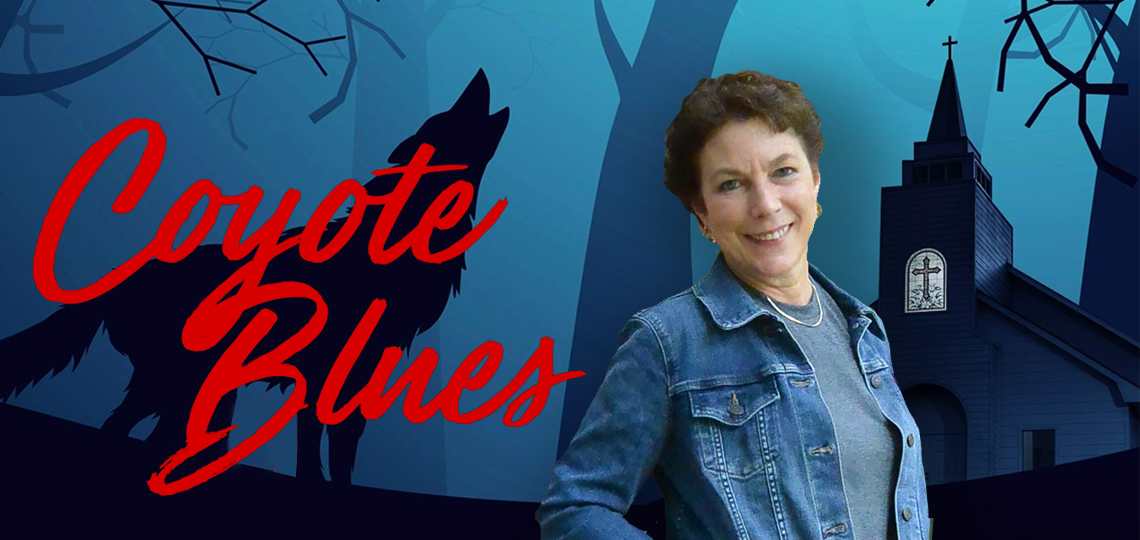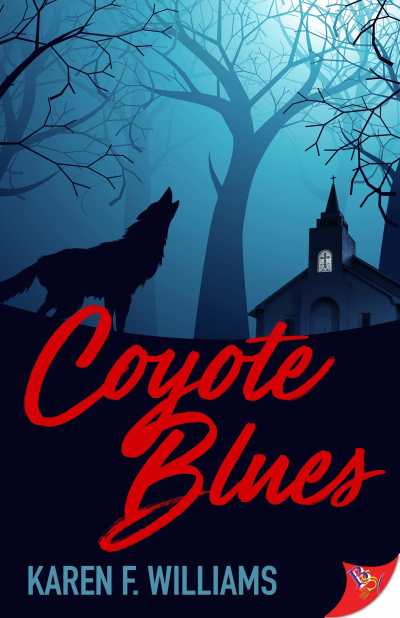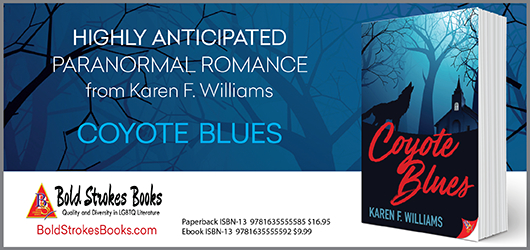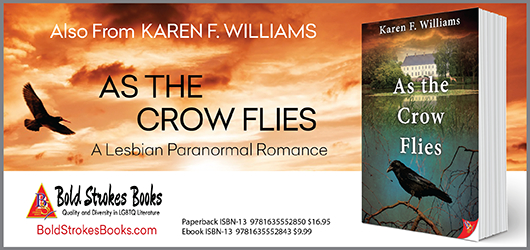From Archetypes to Superdogs—a Discussion with Paranormal Romance Author Karen F. Williams

As much as humans pride themselves on being creatures of logic and reason, we cannot deny our enduring preoccupation with the unseen and unexplained. It may defy logic that your bedroom fills with monsters the moment the lights go out, but that does not make the fear that darkness inspires any less real. Similarly, we look to the stars, to the depths of the ocean, to the untamed wilderness for forms of life beyond our understanding and comprehension, hoping to have the plush rug of reason pulled out from under us. Whatever your poison—aliens, mermaids, Bigfoot—we all have an inner Mulder that desperately wants to believe.

As a balm to this curiosity that may never be sated with proof, we turn to the page and the screen, expanding kernels of folklore into reams of supernatural canon. Our limitless imaginations reach for the supernatural in our everyday lives, proposing answers to questions such as “What would high school be like for a werewolf?” and “What if zombies helped solve murders?” Karen Williams poses a different question in her novel, Coyote Blues: “What if a werecoyote fell in love?”
Found abandoned on a forest path and adopted as an infant, Riley has no idea who—or what—she is beyond her parents’ rules and expectations. When she begins changing into a coyote as a teenager, her adoptive parents all but pack her bags and ship her off to college with instructions never to return. Forced to abandon the woman she loves, Riley tries to carve out a new life for herself, providing others with the helping hand she was denied. When the love of her life drifts back into her orbit, Riley hopes for a second chance, but she’ll have to fight a monster much more dangerous than a werecoyote to get there.
Like a dog with a bone, we reached out to Bold Strokes Books to connect with Karen for an interview. We’re sure you’ll have a howling good time with her answers.
First off, what inspired you to put a twist on the traditional werewolf lore with the inclusion of coyotes?
I suppose my choice of animal (Canis lupus vs. Canis latrans) goes back to the old adage, “write what you know.” I don’t personally know any wolves, but I do know plenty of coyotes.
I share my land with two resident packs and have come to know them well. On occasion, usually during the dead of winter, I get to glimpse what is called a transient coyote: a lone and sometimes elderly drifter passing through to points unknown. Then autumn brings dispersal coyotes. Those are the young males dispersing from their birthplace to establish their own territories. Unfortunately, dispersals have the highest mortality rate. With more brawn than brains, more testosterone than experience, and without the protection of wiser parents, they’re easy targets for trappers and sport hunters.
But back to the resident packs, my property is their safe space, and in turn they afford me the privilege of observing them. I keep trail cameras up at night, but contrary to the belief that coyotes are strictly nocturnal, they do hunt and forage during the afternoons, providing there are no threats. Feeding primarily on small prey—mice, squirrels, frogs, insects, fruit, etc.—they’re mostly singular hunters, not relying, as wolves do, on the highly organized structure of a large pack necessary for taking down big prey. Subsequently, packs can have as much variety as human families do. Right now, one is what you’d call a “traditional family” (mother, father, and two adolescents who care for the younger sibling born this spring). The other is comprised of two older females and their adult offspring.
Coyotes also prefer to live and sleep out in the open, with dens being used primarily for whelping pups, so during the writing of my novel I had ample opportunity to study behaviors which helped in the portrayal of what I hope is a fairly accurate and respectable werecoyote. And I must say, the coyotes here really are respectful neighbors. I have three fenced acres so that my dogs can run and play, but the fence is only three feet high—no obstacle for a coyote! Yet they’ve never jumped the fence. This might also have to do with the boundary line being duly marked with urine, thanks to Black Jack, our twelve-pound kick-ass chihuahua, who spends considerable time marking the entire perimeter, and consumes mass quantities of water to accomplish his daily work. He’s a ridiculous alpha male, the epitome of masculine toxicity.
What’s funny, though, is that sometimes when we’re out in the woods, he’ll spot a coyote looking down from the hills and goes absolutely ballistic. His ranting and raving alerts our pit-mix, who quietly sneaks up behind Jack to calmly stand guard. It’s a comical scene, like those cartoons where the little, hot-tempered guy with a chip on his shoulder is all up in arms, cursing and shaking his fists at the bigger guy. And the big guy takes off—not because he’s scared of the little guy, but because he’s afraid of the much larger fellow who has the little guy’s back. And Jack, unaware of the dynamics playing out, takes full credit for chasing away the intruder. He swells with pride, kicking up the dirt behind him, then struts back to the house like the pigmy-sized Tarzan he is, completely satisfied with himself.
All in all, for ten years our relationship with the coyotes has remained a peaceful one. They simply aren’t the monstrous killers people think they are. And I hope my book, aside from being a thrilling shape-shifter romance, will change readers’ perceptions of these cryptic, clever, and maligned “superdogs” who have been the target of extermination programs for decades. At the end of day, coyotes are just out there trying to make a living like the rest of us.
Your cast of characters is an intimate but varied group—from sage psychotherapist Peggy to the affable, easy-on-the-eyes Reverend Cortez. Is there one particular character you relate to or enjoyed writing the most? What draws you to that character?
When you describe Dr. Peggy Spencer as a sage, you hint at archetypes—those universal symbols of human nature that hail from our ancestral past and come to life in mythical stories. Being twenty years older than Riley and her former professor, not to mention a maternal figure, Peggy certainly does embody the sage archetype: mentor, guide, crone, wise elder. Jim, the self-righteous and abusive husband, is definitely the archetypal shadow or villain. I guess Fiona, Riley’s long-lost love, fits the damsel in distress archetype of fairy tales. And the mysteriously dark and handsome Reverend Cortez (I’m glad you like his character because I loved writing him) serves as the archetypal guardian who protects the hero in her quest. Now that I think about it, even Fiona’s daughter, the precocious ten-year-old, embodies the archetypal “herald” in that she stirs the hero to action in this paranormal story which Joseph Campbell might refer to as the monomyth, or hero’s adventure. In his introduction to A Hero With a Thousand Faces, Campbell summarizes the monomyth: “A hero ventures forth from the world of common day into a region of supernatural wonder. Fabulous forces are there encountered and a decisive victory is won.”
Of course, in Coyote Blues, as is pretty much the norm in magical realism and most urban/contemporary fantasies, the hero doesn’t have to travel far because those fabulous forces and supernatural wonders make their way into the ordinary world. The journey, although it may involve a physical battle, is more of a spiritual one.
Speaking of heroes, you asked what character I relate to the most. I think most authors see themselves in the role of protagonist, and considering my affinity with animals, I loved trying to get into the mind of a coyote and become one. Wouldn’t it be sublime to actually experience that? To know what they think and feel, how they experience the world? Of course, in fairy tales, folklore, and other mythological narratives, the coyote is always the trickster (another archetype) who creates mischief to confuse and sabotage the hero. But in this story, the protagonist is both ousted trickster and the hero who must trick the villain to save a woman and her child.
Rejected by her wealthy, adoptive parents, Riley’s lycanthropic affliction has rendered her a societal outcast. She’s spent the past twenty years pretty much living a solitary life of secrecy. But it’s been a comfortable life. She has money, a career, and the support of three people who hold her dear and keep her secret. But as she begins the hero’s adventure, she must choose to give up her security, risk exposure, and possibly her own life. She prepares herself to make the ultimate sacrifice, should her plan to foil the villain fail.
The study and practice of psychology plays an important role in your novel, with almost all of the characters being involved in that world in some aspect or another. These elements, particularly within academia, seemed very well researched. Do you have any experience in the field, or, if not, could you give us some insight into how you approached researching such a complex discipline?
Like Dr. Peggy Spencer, and my main character, Riley Dawson, I’m an LCSW (licensed clinical social worker). I began my career in forensic psychiatry (think group therapy with the criminally insane). The idea of working with antisocial personalities always intrigued me, maybe because psychopaths and serial killers tend to be romanticized in the movies. When I first took the position I thought, wow, this is going to be fascinating. I felt like Jodie Foster trying to understand the mind of Hannibal Lector. That feeling faded fast. In reality, there’s nothing fascinating about sadistic people who are devoid of a conscience, incapable of empathy, unable to feel mercy or remorse. Four years later, I moved on to private practice and to the public-school system, evaluating special needs children, working with teenagers and families struggling with mental health issues. But throughout my career I did write. My first paranormal romance, still in print, came out in the 90s, and my love of animals (I’m also a licensed wildlife rehabilitator) sparked a professional interest in the human-animal bond. I’ve taught adult education classes and published articles on the subject. In fact, my essay on unconditional love appears in the current Spring 2020 issue of Bark magazine.
Faith and religiosity is also a significant theme within the novel, and is not something often emphasized in supernatural fiction. Why did you feel adding that layer to your characters’ struggles and self-discoveries was important?
Well, I was raised in the church. My grandfather was a minister and missionary. So, there’s that. My parents were accepting of my sexual orientation, but still I grappled with being gay because of the general Christian consensus that you can’t be gay and go to heaven. And queer folk aren’t the only ones banned from the pearly gates. Supposedly animals aren’t welcome either because they don’t have souls. But how could this be true when they’re capable of love, and as different and unique as people? I never could wrap my head around the notion that the rainbow bridge leads nowhere. I think those old Christian philosophers, Descartes being a prime example, were the worst thing that ever happened to animals. They perpetuated the religious belief that non-humans are nothing more than organic machines, incapable of thought and emotion, impervious to pain and suffering, and soulless. But if they are soulless (and I don’t believe they are) where would this leave a werewolf, being half human and half animal? Would it have a soul?
While researching and writing Coyote Blues, I happened upon an article in the science section of the New York Times. You might remember the chimera from Greek mythology, that hybrid creature who was part goat, part lion, part serpent. Today, a chimera is what scientists call a lab animal with two distinct DNA profiles: a mouse injected with human stem cells, say, or a pig embryo modified with human DNA, the purpose of which is to one day perform pig-to-human heart transplants without the body rejecting them. It’s causing an uproar among religious leaders who argue that if a chimera is part human, even five percent, then might it have a soul? And if so, do we have the moral right to kill and harvest its organs?
Anyway, all this got me thinking, as these things usually do (I’m laughing here). But really, if the mythical werewolf did exist, it would be a chimera, half human, half animal—a single organism with two separate DNA profiles. I thought my readers would find this interesting, and Reverend Cortez’s character, aside from being integral to the plot, became a platform for exploring these ideas.
Without giving anything away, let’s just say that Coyote Blues ends primed for an adventurous sequel. Are you working on that, or anything else, at the moment?
Ah. If you’ll pardon the pun, here I’ll have to “shift” from werecoyote and chimera to lich (rhymes with itch). Interesting word. It’s an old term for corpse. Think of lichgate, which is the entrance to a cemetery, or the covered threshold in a churchyard through which a coffin is carried to its final resting place. It symbolizes the passing from this world to the next. In the world of horror and fantasy, lich has become synonymous with necromancers and the undead.
All I will tell you is that the story, another paranormal romance, begins with a fabulous blind date. Sydney Wade is a master plumber, certified landscape designer, and co-owner of Wade and Wallow Aquascapes, a business that specializes in pond construction. When her partner sets her up on a blind date with Elle Woodworth, Sydney thinks she’s met the woman of her dreams…until she discovers Elle is a mortician and the county coroner. It’s too much for Sydney to handle. Knowing where the woman’s hands have been, she can’t bear the thought of those hands touching her, so she “ghosts” Elle, ignoring her calls and texts. Two months later, Sydney’s brother dies and she finds herself making arrangements at the Woodworth Funeral Home. Terribly embarrassed to be sitting with Elle, and feeling guilty for being such a jerk, Sydney insists on repaying Elle’s kindness by turning the funeral home’s garden fountain into a beautifully landscaped koi pond, free of charge. But problems arise when Sydney accidentally unearths an ancient looking box containing—you guessed it—a lich, and all hell breaks loose.
I’ll leave you with that for now.
Danielle Ballantyne


![“Injustice and self-acceptance drive this excellent paranormal lesbian romance … [Williams] manages to tug at the heartstrings wihtout being preachy … Grounded in kindness, queerness, and just a hint of magic, this is sure to satisfy.”—Publishers Weekly BoldStrokeBooks.com Paperback ISBN: 9781635555585 $16.95 Ebook ISBN-13 9781635555592 $9.99](https://www.forewordreviews.com/foresights/art/80426-w600.jpg)
